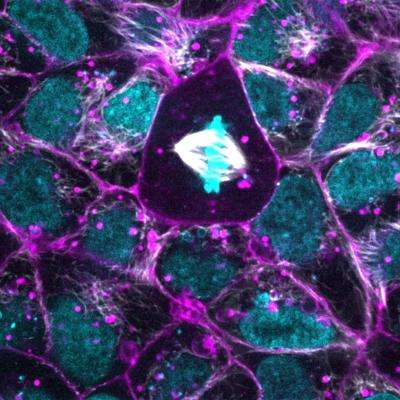A cluster of human induced pluripotent stem cells (hiPSCs) highlighted with dyes that detail cell membranes (purple) and DNA in the nucleus (blue). Spindles from microtubules (white), seen in the center of the image, aid in cell division. Credit: Allen Institute for Cell Science
The Allen Institute for Cell Science has released the Allen Cell Collection: the first publicly available collection of gene edited, fluorescently tagged human induced pluripotent stem cells that target key cellular structures with unprecedented clarity.
Distributed through the Coriell Institute for Medical Research, these powerful tools are a crucial first step toward visualizing the dynamic organization of cells to better understand what makes human cells healthy and what goes wrong in disease.
"Each of our cells—the fundamental units of life—are like a city, with people and resources that move around and factories that generate those resources and carry out important functions," says Rick Horwitz, Ph.D., Executive Director of the Allen Institute for Cell Science. "With these cell lines, we aim to give the cell science community a kind of live traffic map to see when and where the parts of the cell are with the clarity and consistency they need to make progress toward understanding human health and tackling disease."
Scientists at the Allen Institute for Cell Science used CRISPR/Cas9 technology to insert fluorescent tags for major cellular structures into human induced pluripotent stem cells. Unlike typical methods which flood the cell with fluorescent protein, these highly precise tags show exactly when and where the structures are at various stages in the cell's lifecycle.
High-magnification timelapse movie of a hiPSC colony expressing alpha tubulin-mEGFP; a fluorescent tag on microtubules -- a component of the cell's inner skeleton. Images taken in 3-D every 1 minute for 65 minutes. Image is a maximum intensity projection Movie sped up 900x over real time. Credit: Allen Institute for Cell Science
"By lowering the barrier to entry for cell biologists wishing to work on iPS cells, the availability of these lines will usher in a new era in cell biology," says Anthony Hyman, Ph.D., Director and Group Leader at the Max Planck Institute of Molecular Cell Biology and Genetics.
This first collection of five cell lines targets a set of major cellular structures that help to orient the cell. These include the nucleus (tagged by the protein lamin B1), mitochondria (Tom20), microtubules (alpha-tubulin), cell-to-cell junctions (desmoplakin) and adhesion (paxillin). Subsequent collections will be released throughout 2017.
"This kind of precise fluorescent tagging of structures in human stem cells is valuable for a variety of reasons, not least of which is that the pluripotent stem cells can be turned into a large number of cell types, like heart, brain or skin," says Ruwanthi Gunawardane, Ph.D., Director of Stem Cells and Gene Editing at the Allen Institute for Cell Science. "Our cells are healthy and as close to normal human cells as we can study in the lab, making these cell lines a powerful platform to identify the functions of genes, screen drugs, determine differentiation state and much more."
Learn about the Allen Cell Collection: The first publicly available collection of gene edited, fluorescently tagged human induced pluripotent stem cells. Credit: Allen Institute for Cell Science
"With these tagged cell lines, we get to 'spy' on the organization of healthy, normal human cells in a way that scientists never could before," says Susanne Rafelski, Ph.D., Director of Assay Development at the Allen Institute for Cell Science. "The images and movies we can generate from these lines show the cell's major structures with astonishing clarity and empower a broad, multi-structure view of how cells change as they execute their various activities and turn into different kinds of cells."
The cell lines will be available for scientists around the world to use not just to understand the fundamentals of the cell, but also to investigate disease. Key mutations can be introduced to the cells in order to study how disease progresses in a dish, with broad potential impacts on the fields of biomedical science and personalized medicine.
Provided by Allen Institute for Brain Science



















